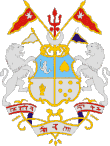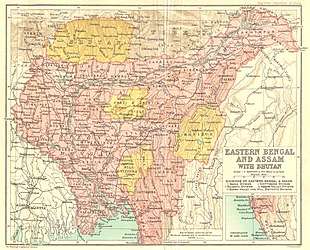Manikya dynasty
The Manikya dynasty was the ruling house of the Twipra Kingdom and later the princely Tripura State, what is now the Indian state of the same name. Ruling since the early 15th century, the dynasty at its height controlled a large swathe of the north-east of the Indian subcontinent. After coming under British influence, in 1761 they transitioned from feudal monarchs into rulers of a princely state, though the Manikyas maintain control of the region until 1949, when it ascended in union with India.
| Manikya | |
|---|---|
 | |
| Parent house | Lunar dynasty (legendary) |
| Country | |
| Founded | c.1400 |
| Founder | Maha Manikya |
| Current head | Kirit Pradyot Manikya |
| Final ruler | Kirit Bikram Kishore Manikya |
| Titles | |
| Deposition | 1949 |
History
Tracing a descent from the mythological Lunar dynasty,[1] the Rajmala royal chronicle records an unbroken line of 144 (likely legendary) monarchs of Tripura up to the ascension of one Ratna Fa, who is stated to have become the first Manikya after being granted the cognomen by the Sultan of Bengal.[2] However, it is now believed that the Rajmala had been mistaken in the genealogy and chronology of the initial Manikya rulers.[3] Numismatic evidence suggests that the first historical Manikya was in fact Maha Manikya,[4] a Tripuri chief who founded the kingdom after establishing dominance over neighbouring tribes in the early 1400s.[5] This monarch then took the title "Manikya" in honour of a historic victory over Bengal, with the name being inherited by his descendants.[6]
Maha Manikya's early successors achieved considerable military success, conquering territory in Bengal, Assam and Burma. Tripura reached its zenith in the 16th century under such prominent kings as Dhanya Manikya and Vijaya Manikya II,[7] with its lands stretching from the Garo Hills in the north to the Bay of Bengal in the south. As monarchs of a Hindu kingdom, the Manikyas developed a rivalry with the successive Muslim rulers of Bengal, coming into conflict with Sultans, governors and Nawabs before being brought under Mughal suzerainty in the early 17th century. As Mughal power waned, the antagonism with Bengal re-erupted, which drove the Manikyas to first approach the British for aid. In 1761, Tripura had succumb to British influence, becoming a princely protectorate, though control of the region remained under the Manikya dynasty.[8]
In 1870, Bir Chandra Manikya ascended the throne and began a series of political reforms to his kingdom, modelling his government on the British system. A lover of the culture of Bengal, Bengali was adopted by the court under his rule and he developed a friendship with the celebrated poet, Rabindranath Tagore. After Tripura was briefly incorporated into the province of Eastern Bengal and Assam at the beginning of the 20th century, the last Manikya monarch, Maharaja Bir Bikram Kishore, chose to come under the jurisdiction of the predominantly Hindu Dominion of India in 1947. The final ascension of Tripura into the modern Indian nation was signed by his widow, Kanchan Prava Devi, in place of the minor Kirit Bikram Kishore, bringing to an end five centuries of Manikya rule.[8]
List of rulers

| Kingdom of Tripura | |||||||||||||||||||||||||||||||||||||||||||||||||||||||||||||||||||||||||||||||||||||||||||||||||||||||
|---|---|---|---|---|---|---|---|---|---|---|---|---|---|---|---|---|---|---|---|---|---|---|---|---|---|---|---|---|---|---|---|---|---|---|---|---|---|---|---|---|---|---|---|---|---|---|---|---|---|---|---|---|---|---|---|---|---|---|---|---|---|---|---|---|---|---|---|---|---|---|---|---|---|---|---|---|---|---|---|---|---|---|---|---|---|---|---|---|---|---|---|---|---|---|---|---|---|---|---|---|---|---|---|
| Part of History of Tripura | |||||||||||||||||||||||||||||||||||||||||||||||||||||||||||||||||||||||||||||||||||||||||||||||||||||||
| |||||||||||||||||||||||||||||||||||||||||||||||||||||||||||||||||||||||||||||||||||||||||||||||||||||||
| Tripura monarchy data | |||||||||||||||||||||||||||||||||||||||||||||||||||||||||||||||||||||||||||||||||||||||||||||||||||||||
| Manikya dynasty (Royal family) | |||||||||||||||||||||||||||||||||||||||||||||||||||||||||||||||||||||||||||||||||||||||||||||||||||||||
| Agartala (Capital of the kingdom) | |||||||||||||||||||||||||||||||||||||||||||||||||||||||||||||||||||||||||||||||||||||||||||||||||||||||
| Ujjayanta Palace (Royal residence) | |||||||||||||||||||||||||||||||||||||||||||||||||||||||||||||||||||||||||||||||||||||||||||||||||||||||
| Neermahal (Royal residence) | |||||||||||||||||||||||||||||||||||||||||||||||||||||||||||||||||||||||||||||||||||||||||||||||||||||||
| Rajmala (Royal chronicle) | |||||||||||||||||||||||||||||||||||||||||||||||||||||||||||||||||||||||||||||||||||||||||||||||||||||||
| Tripura Buranji (Chronicle) | |||||||||||||||||||||||||||||||||||||||||||||||||||||||||||||||||||||||||||||||||||||||||||||||||||||||
| Chaturdasa Devata (Family deities) | |||||||||||||||||||||||||||||||||||||||||||||||||||||||||||||||||||||||||||||||||||||||||||||||||||||||
| Rulers of the Manikya dynasty (c.1400 – 1949)[9][10] | |||||||||
| Name | Reign start | Reign end | Claim | Notes | |||||
|---|---|---|---|---|---|---|---|---|---|
| Maha Manikya | c.1400 | 1431 | |||||||
| Dharma Manikya I | 1431 | 1462 | Son of Maha Manikya | ||||||
| Ratna Manikya I | 1462 | c.1487 | Son of Dharma Manikya I | ||||||
| Pratap Manikya | c.1487 | c.1487 | Son of Ratna Manikya I | ||||||
| Vijaya Manikya I | 1488 | 1488 | Possibly son of Pratap Manikya | ||||||
| Mukut Manikya | 1489 | 1489 | Son of Ratna Manikya I | ||||||
| Dhanya Manikya | 1490 | 1515 | Son of Ratna Manikya I | ||||||
| Dhwaja Manikya | 1515 | 1520 | Son of Dhanya Manikya | ||||||
| Deva Manikya | 1520 | 1530 | Son of Dhanya Manikya | ||||||
| Indra Manikya I | 1530 | 1532 | Son of Deva Manikya | ||||||
| Vijaya Manikya II | 1532 | 1563 | Son of Deva Manikya | ||||||
| Ananta Manikya | 1563 | 1567 | Son of Vijaya Manikya II | ||||||
| Udai Manikya | 1567 | 1573 | Father-in-law of Ananta Manikya | Claimed the throne following the death of his predecessor, briefly supplanting the ruling dynasty with his own line.[11] | |||||
| Joy Manikya I | 1573 | 1577 | Son of Udai Manikya | ||||||
| Amar Manikya | 1577 | 1585 | Son of Deva Manikya | Restored the Manikya dynasty after killing his predecessor.[12] | |||||
| Rajdhar Manikya I | 1586 | 1600 | Son of Amar Manikya | ||||||
| Ishwar Manikya | 1600 | 1600 | Possibly son of Amar Manikya or Rajdhar Manikya I | ||||||
| Yashodhar Manikya | 1600 | 1618 | Son of Rajdhar Manikya I | Monarchy temporarily overthrown by the Mughal Empire.[13] | |||||
| Kalyan Manikya | 1626 | 1660 | Descendant of Maha Manikya | From a cadet branch of the dynasty.[14] Elected as monarch after Mughal interregnum.[15] | |||||
| Govinda Manikya | 1660 | 1661 | Son of Kalyan Manikya | First reign | |||||
| Chhatra Manikya | 1661 | 1667 | Son of Kalyan Manikya | ||||||
| Govinda Manikya | 1667 | 1673 | Son of Kalyan Manikya | Second reign | |||||
| Rama Manikya | 1673 | 1685 | Son of Govinda Manikya | ||||||
| Ratna Manikya II | 1685[16] | 1693[16] | Son of Rama Manikya | First reign | |||||
| Narendra Manikya | 1693[16] | 1695[16] | Grandson of Govinda Manikya | ||||||
| Ratna Manikya II | 1695[16] | 1712[16] | Son of Rama Manikya | Second reign | |||||
| Mahendra Manikya | 1712[17] | 1714[17] | Son of Rama Manikya | ||||||
| Dharma Manikya II | 1714[17] | 1725[17] | Son of Rama Manikya | First reign | |||||
| Jagat Manikya | 1725[18] | 1729[18] | Great-grandson of Chhatra Manikya | ||||||
| Dharma Manikya II | 1729[18] | 1729[18] | Son of Rama Manikya | Second reign | |||||
| Mukunda Manikya | 1729 | 1739 | Son of Rama Manikya | ||||||
| Joy Manikya II | 1739 | 1744 | Descendant of Chhatra Manikya | ||||||
| Indra Manikya II | 1744 | 1746 | Son of Mukunda Manikya | ||||||
| Vijaya Manikya III | 1746 | 1748 | Brother of Joy Manikya II, descendant of Chhatra Manikya | ||||||
| Lakshman Manikya | ? | ? | Grandson of Dharma Manikya II | Ruled as a puppet-monarch under Shamsher Gazi for three years before the latter took the throne for himself.[19] | |||||
| Krishna Manikya | 1760 | 1783 | Son of Mukunda Manikya | ||||||
| Rajdhar Manikya II | 1785 | 1806 | Grandson of Mukunda Manikya | ||||||
| Rama Ganga Manikya | 1806 | 1809 | Son of Rajdhar Manikya II | First reign | |||||
| Durga Manikya | 1809 | 1813 | Son of Lakshman Manikya | ||||||
| Rama Ganga Manikya | 1813 | 1826 | Son of Rajdhar Manikya II | Second reign | |||||
| Kashi Chandra Manikya | 1826 | 1829 | Son of Rajdhar Manikya II | ||||||
| Krishna Kishore Manikya | 1829 | 1849 | Son of Rama Ganga Manikya | ||||||
| Ishan Chandra Manikya | 1849 | 1862 | Son of Krishna Kishore Manikya | ||||||
| Bir Chandra Manikya | 1862 | 1896 | Son of Krishna Kishore Manikya | ||||||
| Radha Kishore Manikya | 1896 | 1909 | Son of Bir Chandra Manikya | ||||||
| Birendra Kishore Manikya | 1909 | 1923 | Son of Radha Kishore Manikya | ||||||
| Bir Bikram Kishore Manikya | 1923 | 1947 | Son of Birendra Kishore Manikya | ||||||
| Kirit Bikram Kishore Manikya | 1947 | 1949 | Son of Bir Bikram Kishore Manikya | ||||||
| Pretenders (1949 – present) | |||||||||
| Kirit Bikram Kishore Manikya | 1949 | 2006 | Son of Bir Bikram Kishore Manikya | ||||||
| Kirit Pradyot Manikya | 2006 | Son of Kirit Bikram Kishore Manikya | |||||||
References
- Singh Rana (1998), p. 210.
- Bhattacharyya (1977), p. 13.
- Saha (1986), p. 168.
- Sarma (1987), p. 39.
- Momin, Mawlong & Qādrī (2006), p. 81.
- Lahiri (1999), p. 53.
- Nayar (2005), p. 70.
- Boland-Crewe & Lea (2005), p. 238.
- Sarma (1987), pp. 233–34.
- Raatan (2008), pp. 145–57.
- Sarma (1987), pp. 75–76.
- Sarma (1987), p. 77.
- Chib (1988), p. 11.
- Gan-Chaudhuri (1980), p. 25.
- Sarma (1987), p. 96.
- Friedberg & Friedberg (2009), p. 498.
- DebBarma (2006), p. 24.
- DebBarma (2006), p. 25.
- Sur (1986), p. 14.
Bibliography
- Bhattacharyya, A. K. (1977). District Census Handbook: North Tripura. Director of Census Operations.CS1 maint: ref=harv (link)
- Boland-Crewe, Tara; Lea, David (2005) [2002]. The Territories and States of India. London: Routledge. ISBN 978-1-135-35625-5.CS1 maint: ref=harv (link)
- Chib, Sukhdev Singh (1988). This beautiful India: Tripura. Ess Ess Publications. ISBN 978-81-7000-039-6.CS1 maint: ref=harv (link)
- DebBarma, Chandramani (2006). Glory of Tripura civilization: history of Tripura with Kok Borok names of the kings. Parul Prakashani.CS1 maint: ref=harv (link)
- Friedberg, Arthur L.; Friedberg, Ira S. (2009). Gold Coins of the World: From Ancient Times to the Present : an Illustrated Standard Catalogue with Valuations (8 ed.). New Jersey: Coin & Currency Institute. ISBN 978-0-87184-308-1.CS1 maint: ref=harv (link)
- Gan-Chaudhuri, Jagadis (1980). Tripura, the land and its people. Leeladevi Publications.CS1 maint: ref=harv (link)
- Lahiri, Bela (1999). "Numismatic Evidence on the Chronolgy and Succession of the rulers of Tripura". The Journal of the Numismatic Society of India. Numismatic Society of India.CS1 maint: ref=harv (link)
- Momin, Mignonette; Mawlong, Cecile A.; Qādrī, Fuz̤ail Aḥmad (2006). Society and economy in North-East India. New Delhi: Regency Publications. ISBN 978-81-87498-83-4.CS1 maint: ref=harv (link)
- Nayar, V. K. (2005). Crossing the Frontiers of Conflict in the North East and Jammu and Kashmir: From Real Politik to Ideal Politik. New Delhi: Shipra Publications. ISBN 978-81-7541-218-7.CS1 maint: ref=harv (link)
- Raatan, T. (2008). Encyclopaedia of North-East India. Gyan Publishing House. ISBN 978-81-7835-068-4.CS1 maint: ref=harv (link)
- Saha, Sudhanshu Bikash (1986). Tribes of Tripura: A Historical Survey. Rupali Book House.CS1 maint: ref=harv (link)
- Sarma, Ramani Mohan (1987). Political History of Tripura. Puthipatra.CS1 maint: ref=harv (link)
- Singh Rana, J. P. (1998). Marriage and Customs of Tribes of India. New Delhi: M.D. Publications Pvt. Ltd. ISBN 978-81-7533-087-0.CS1 maint: ref=harv (link)
- Sur, Hirendra Kumar (1986). British Relations with the State of Tripura, 1760-1947. Saraswati Book Depot.CS1 maint: ref=harv (link)